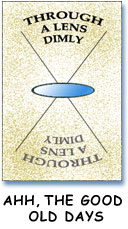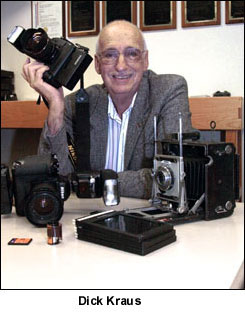|
|
|
|
|
|
THROUGH A LENS DIMLY AHH,
THE GOOD OLD DAYS There were two shutters on these cameras. One was a Compur shutter mounted on a lens board on the front of the bellows. This was comprised of several thin metal leaves which were driven by spring tension. You could adjust the tension on the springs to make the leaves of the shutter open and close more quickly or more slowly. The second was a Focal Plane Shutter which was placed towards the back of the camera, just in front of the film (which was known as the focal plane.) The Focal Plane Shutter was a roll of rubberized cloth that had several different sized openings which passed in front of the film. The largest opening allowed more light to reach the film and took longer to pass over the film, ergo, a slow shutter speed. The thinner openings passed over the film more quickly giving us a faster shutter speed. There was also a tensioned coil spring that was adjustable to make each of these openings go by the film faster or slower. Before making each exposure, the photographer would have to decide what shutter speed was required and then would roll the curtain to the spot where the desired opening in the curtain would be set (you can see the winding key for the Focal Plane Shutter curtain at the upper rear of the camera body in the photo below.) Then you had to adjust the spring tension to get the exact exposure. Whichever
shutter you decided to use, it was necessary for the other shutter
be set in an open position. The front shutter was much
easier and convenient to use for news work, so the rear shutter
was always left open.
This
is the good part. Back in those good old days, the competition
among the various newspapers was very, very intense. Most
of the old news photographers got along, for the most part. But
if there was a major story breaking, it was not uncommon for
a
competitive
photographer to try to get an exclusive photo by whatever means
possible. In New York City alone, in those days, there were
about a dozen daily newspapers. On a big story, that meant a dozen
news photographers trying to beat out their competition. And,
oh yeah, let's not forget the 3 or 4 photo agencies that were
around,
then, too. For more information on "The Good Old Days" see "The Good Old Days" see "Life Before Digital (Continued)" |
||


